|

by Andrew Collins
October 03,
2018
from
AndrewCollins
Website
(PDF
version)
Spanish
version
Italian
version
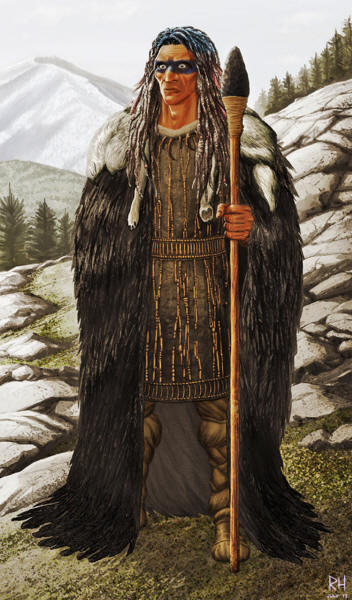
Artist impression of an Animiki' by Russell M. Hossain.
The Thunder People' s possible origin as pronounced
Denisovan hybrids is reflected in the figure' s archaic features
and greater height, as well as the cold mountainous terrain
seen in the background
(pic copyright: Russell M. Hossain, 2018).
Abstract
Algonquian language-speaking groups of the Great Lakes
and St Lawrence River region of North America preserve
traditions regarding the Animiki', generally translated
into English as "thunderbird," "thunderers" or "thunder
people."
Primarily these are sky manitous (spirits), who bring
forth lightning, thunder and rain storms.
However, separate traditions held by these peoples talk
about the Animiki' being shape-shifting giants birds
that can assume human form by removing their "feather
blankets," and even have mortal families.
The
author proposes that earthly Animiki' are a memory of
Denisovan and arguably Denisovan-Neanderthal-modern
human groups that thrived in parts of North America
through until the first millennia BC, when they became
the extremely tall ruling elites and shamans of the
Adena mound-building culture (the so-called "Adena
elite" theory).
Knowledge that modern Algonquian language-speaking
populations such as the Ojibwa and Cree likely possess
Denisovan ancestry, while the Denisovans themselves are
now thought to have been of large stature, adds weight
to these suggestions.
In 2010 the existence of a previously unknown archaic human
population was discovered following the DNA sequencing of a finger
bone over 41,000 years old.
It had been found two
years earlier in the Denisova Cave, a Stone Age occupational site
located in the Altai Mountains of southern Siberia. Here also three
molars, two of enormous size, were retrieved. These too were found
to belong to this same group of archaic humans, who are today known
as
the Denisovans after their place of
discovery.
Although to date these remain the only confirmed fossils relating to
this extinct population, the sequencing of the Denisovan genome by
the Department of Human Evolution at the
Max Planck Institute for Evolutionary
Anthropology in Leipzig, Germany, has allowed us to
determine that many modern-day human populations carry Denisovan
ancestry (see fig. 1).
Most of these populations
are located in central, southern and eastern Asia. (1)
Others are found among
the indigenous peoples of Papua New Guinea, Australia, and the
Solomon Islands in the South Pacific.
We know also from archaeological discoveries made in the
Denisova Cave that prior to their
disappearance around 40,000 years ago the Denisovans displayed clear
evidence of advanced human behavior.
This included the
creation of the beautiful Denisovan bracelet, a green stone bangle
of immense sophistication, now accepted to be as much as
60,000-70,000 years old.
There is compelling
evidence also that the Denisovans,
-
used bone needles
to manufacture tailored clothing
-
developed highly
advanced stone tool technologies
-
fashioned the
earliest known musical instrument in the form of a bone
flute or whistle
-
perhaps even
domesticated and rode horses
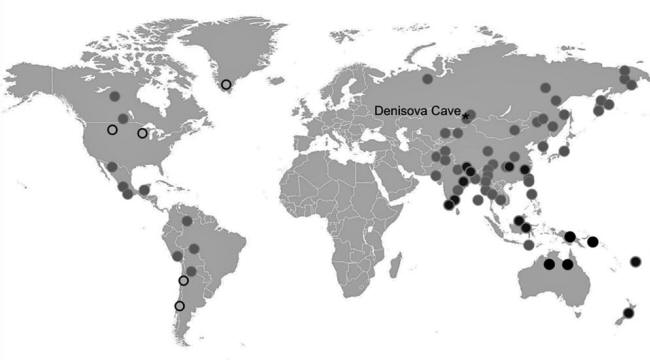
Fig. 1.
Map
showing the distribution of Denisovan DNA
in
modern populations based on the Altaic Denisovan genome
(after
Sankararaman et al 2016).
Black
circles 3-5 percent. Grey circles with black rings 2-3 percent.
Grey
circles 1-2 percent. Values are approximate only.
Black
rings indicate locations of more
recent
discoveries of Denisovan ancestry
(after
Qin and Stoneking 2015).
That so-called archaic humans achieved such a sophisticated
lifestyle quite separately from that of modern human populations,
leads us to the potential impact of the Denisovans on the
development of our own civilization, a matter examined by the
present writer in new book
The Cygnus Key. (2)
-
And what about
the Americas?
-
What might have
been the Denisovans' impact on the continent prior to the
submergence around 8500 BCE of the Beringia land bridge,
which for tens of thousands of years had provided safe
passage between the Russian Far East and Alaska?
Denisovan DNA
We know, for instance, that various First Peoples in both North and
South America possess significant levels of Denisovan DNA. (3)
This includes the Ojibwa,
(4) one of the largest tribes in North America. Their
territories extend from Ontario in Canada down through the Great
Lakes region into Minnesota and Wisconsin.
Originally, however,
their homeland was far to the east in the St Laurence River basin,
in what is today Quebec. The Cree (or Oji-Cree) also possess
Denisovan DNA, although not quite to the same level as the Ojibwa.
(5)
Their ancestral home was
immediately to the north and west of the Ojibwa in Ontario,
Manitoba, Saskatchewan, Alberta, and the Northwest Territories.
They have around 200,000
members today, most of whom live in Canada.
The
Anishinaabeg
Both the Ojibwa and Cree form part of what is known as the
Algonquian language-speaking group, named after
the Algonquin or Algonkin tribe.
This collective of
First Nations refer to themselves,
often above the use of their own individual tribal name, as the
Anishinaabe (plural Anishinaabeg), a word meaning, simply, "original
people," (6) while their shared language is today known
as Anishinaabemowin.
Those belonging to this
interlinked network of tribes, all of which are located in the
northern and northeastern parts of the North American continent (see
fig. 2), include the,
Despite the ethnic and
cultural unity of the Anishinaabeg, it is only the Ojibwa and Cree
that possess significant levels of Denisovan ancestry (other tribes
that do have it include the eastern Algonquin, whose surviving
territories are beyond the northeastern limits of the Great Lakes
region, as well as the Tlingit of the Pacific Northwest). (7)
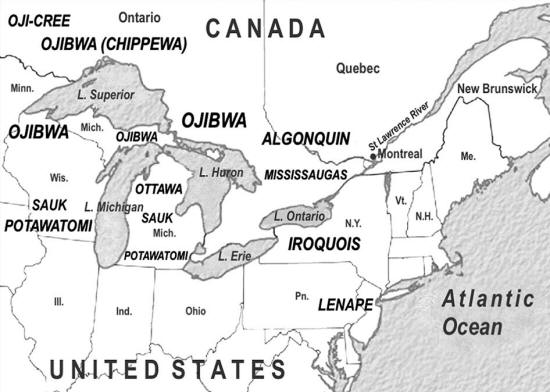
Fig. 2.
Map
showing the territories of
First
Peoples of the Great Lakes and St Lawrence River region
of the
United States and Canada.
Asian Origins
The ancestors of the Algonquian-speaking peoples are thought to have
entered North America from East Asia.
This was made clear in a
comprehensive study of First American DNA based on the genome
sequencing of individuals from populations in,
-
East Asia
-
Australia
-
Oceania
-
North America
-
South America
(8)
Its findings suggest that
the earliest peoples to arrive in North America came from East Asia
around 23,000 years ago.
By 12,500 years ago the
population had split into two distinct branches:
-
One moved
southward contributing to the emergence of the first
indigenous populations to occupy southern North America,
Central America, and South America.
-
The other branch
headed eastward, forming the ancestors of various First
Peoples including the Algonquin, Chippewa, Ojibwa and Cree.
If so then,
-
How exactly did
the Ojibwa and Cree come to possess so much Denisovan DNA?
-
Did their
ancestors gain it prior to arriving in North America, or did
it come from pronounced Denisovan hybrid groups who already
lived on the continent?
One major clue comes from
a most unlikely belief found among the various
Anishinaabeg tribes.
This relates to stories
concerning the prior existence on the continent of a mythical
population known as the Thunder People.
Rise of the
Animiki'
In Ojibwa lore one of the most important groups of
manitous (spirits) were the
so-called Animiki' (a-ni-mi-ki), (9) a name usually
translated as
The thunderbird was
considered a mythical bird, similar to an eagle or falcon. (13)
It controlled elemental
forces such as thunder, lightning, storms, and rain (see fig. 3). It
was looked upon also as the divine source of the magic worked by the
Ojibwa's caste of wild
shamans known as the Jessakid.
(14)
They were seen by early
settlers as,
-
"jugglers"
-
"conjurers"
-
even as
tricksters
Yet to the Ojibwa the
Jessakkid were healers, prophets, seers, as well as the "revealer[s]
of hidden truths," (15) their magical power the gift of
the thunderbird. (16)
In addition to this the Ojibwa recognized the Milky Way as the
Thunderbird's Path, (17) while the thunderbird itself
was identified with the constellation
of Cygnus, known more commonly
today as the Northern Cross. (18)
This is located where the
Milky Way forks into two separate streams, a celestial location
considered by many First Peoples to be the entrance to the land
of the dead. (19)
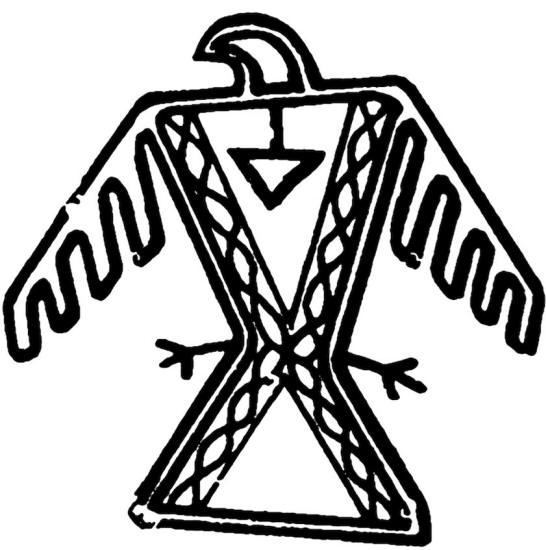
Fig. 3.
Traditional abstract representation
of a
mythical thunderbird manitou.
The Thunder
People
Even though thunderbirds very clearly existed as important spirit
manitous, Ojibwa myths and legends from northern Ontario speak of
the Animiki', or Thunder People, as "giant birds" with clear
anthropomorphic features. (20)
They lived in remote
mountainous areas, and were supposedly encountered by the first
Anishinaabeg. (21)
American ethnologist
Alanson Skinner wrote in 1923 regarding the Algonquian-speaking
Sauk of Wisconsin that to them thunderbirds, the so-called
"Feathered Ones," were,
"giant eagles
inhabiting the western
empyrean, but some maintain that they
resemble human beings or, at least, are anthropomorphic at
times.
They dress like men,
and wear especially elegant fringed leather leggings." (22)
Earthly Animiki' had the
power to conjure thunder and lightning, the latter emitted from
their eyes. (23)
For this reason they were
greatly feared, (24) explaining perhaps the sheer potency
of their memory among the Algonquian-speaking peoples.
-
Is it possible
that stories of the Thunder People preserve the memory of
the former presence in the Great Lakes-St Lawrence River
region of pronounced Denisovan hybrids?
-
Was it from them
that the Ojibwa and Cree gained at least some of their
Denisovan ancestry?
Denisovan
Genes
The connection between the Thunder People and mountainous
terrains is interesting indeed.
Tibetan and Sherpa
populations of the Tibetan plateau possess a special gene, known as
EPAS1, which allows them to live at
extremely high altitudes. This gene, it is now known, was gained
through interbreeding with Denisovans somewhere on the Asian
continent. (25)
They, in turn, must have
developed this gene across tens of thousands, if not hundreds of
thousands, of years. This fact alone tells us that elevated,
mountainous plateaus were the favored terrains of at least some
Denisovan groups.
Such a finding increases
the likelihood that stories of the Thunder People preserve the
memory of surviving pockets of Denisovan hybrid descendents, who
reached North America, most obviously via the Russian Far East, at a
very early date. Most likely this occurred even before 23,000 BC,
when the ancestors of the Algonquian-speaking peoples are thought to
have entered the continent.
Of possible importance here is knowledge that
the Inuit of the Arctic region
possess two special genes that enable them to live in extremely cold
conditions.
These genes (TBX15
and
WARS2) are now thought to have been
inherited from the Denisovans. (26)
So in addition to
existing at very high altitudes, the Denisovans must also have lived
in extremely cold environments for much of the time. Elevated
mountainous regions fit these conditions perfectly.
This therefore provides
additional evidence that the Thunder People were perhaps hybrid
descendants of the Denisovans.
Thunderbird
Shamans
If all this is correct, then stories regarding the earthly Animiki'
most likely relate to the existence of flesh and blood beings.
These archaic humans were
considered to possess extraordinary powers, including the ability to
control thunder and lightning, and bring forth storms and rain.
What is more, their
identification with the mythical thunderbird indicates that they
might well have worn coats of feathers belonging to the eagle, the
principle animistic form of this mythical creature, and even those
of corvids such as the raven. (27)
Certainly, we know that
in Europe
Neanderthals used dark feathers of
raptors, vultures and corvids to create garments of dark feathers.
(28)
They also wore necklaces
of eagle talons, along with those of other large birds (see fig. 4).
(29) Such distinctive forms of dress or decoration are
unlikely to have been for aesthetic purposes alone.
More likely they had a
symbolic function, hinting at the existence of early forms of
shamanism not only among Neanderthals, but also among the Thunder
People of the American continent.
The Roots of
Animism
This would no doubt have included the use of animism to create a
link between the world of the living and perceived
invisible realms, usually only experienced during dreams or
altered states of consciousness.
Shamanic rites involve assuming the spirit of a
particular animal or bird to make the transition from this world to
the realm of the spirit.
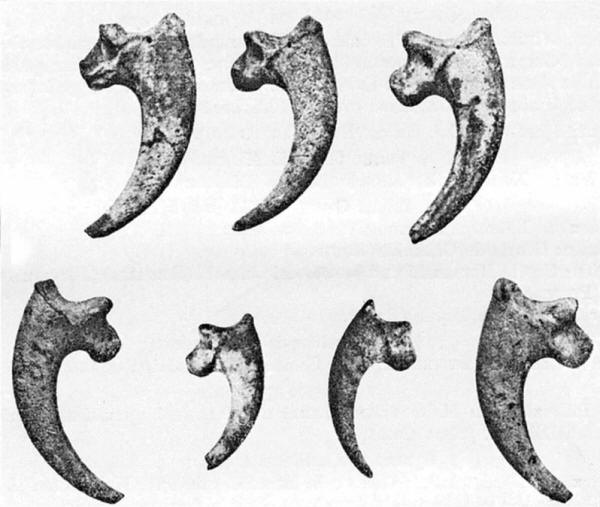
Fig. 4.
Bird
talons used by Neanderthals to create necklaces.
These
examples were found during excavations in the Krapina Cave,
a
130,000-year-old Neanderthal site,
in NW
Croatia, in 1899-1901
(after
Kalman Lambrecht 1933).
Path of Souls
During shamanic experiences of this kind spirit forms would usually
be encountered.
These might have included
ancestral spirits, in other words the spirits of dead ancestors, as
well as denizens of both the Beneath World, or underworld,
and the Upper World, a sky realm accessed via the Milky Way.
On both the Eurasian and
American continents the Milky Way was seen as a path or river along
which the souls of the deceased, along with those of the shaman,
were able to reach the sky world, often in the form of a bird.
Paraphernalia a shaman
might use for such practices included the wing bones and feathers of
birds to achieve astral flight, skulls to link with the spirit or
eyesight of the chosen animal or bird, and talons or claws to
psychically attack potential enemies.
So where exactly did the
concept of animism come from in the first place?
Autistic Gene
To achieve a link with their chosen animal or bird a shaman utilizes
a natural empathy with the creature in question of a type that has
commonly been associated with individuals belonging to the autistic
spectrum. (30)
Autism itself has
long been linked
with the roots of shamanism.
(31)
What is more, a new study
proposes that autistic genes generated by modern humans in harsh ice
age conditions provided them with the mindset to leap ahead in
everything from greater image retention abilities, to higher
aptitudes in identifying and analysing patterns of geography and
movement.
According to the study's authors, medical researcher, Barry
Wright and archaeologist Penny Spikins, both of the
University of York, such autistic talents enabled early modern
humans to develop more efficient hunting tool kits, recall in
absolute detail thousands of square miles of hunting terrain, and
remember and analyze complex patterns of animal behaviour. (32)
All this might be so. However, from the genome of the Altaic
Densiovan we now know that this archaic population possessed two key
genes (ADSL
and
CBTNAP2) linked with autism in
modern human populations. (33)
This does not mean that
all Denisovans were autistic.
There is, however, good
reason to suspect that the Denisovan brain operated in a manner
similar to that of modern human individuals displaying autistic or
savant-like talents.
Not only might this
explain the Denisovans' rapid acceleration in early technologies,
along with their advanced human behavior, but since isolation is a
common trait of autistic people, this might help explain why
Denisovans, and even the Thunder People, thrived in remote
mountainous regions, enduring harsh climates for most of the year.
What is more, an autistic mindset might also help us to understand
how the Denisovans, as the forerunners of the Thunder People, were
able to achieve such a strong mental empathy with creatures of the
natural world.
If so, did this in turn
lead to the development of both animism and shamanism, which, as we
have seen, included the adoption of animal and bird paraphernalia to
make a connection with the spirit realms?
Thunderbird
families
Of relevance here is the fact that the Animiki' are said to have
assumed human form,
"by tilting back
their beaks like a mask, and by removing their feathers as if it
were a feather-covered blanket."
Moreover, we read that
there are,
...stories of
thunderbirds in human form marrying into human families; some
families may trace their lineage to such an event.
Families of
thunderbirds who kept to themselves but wore human form were
said to have lived along the northern tip of
Vancouver Island.
The story goes that
other tribes soon forgot the nature of one of these thunderbird
families, and when one tribe tried to take them as slaves, the
thunderbirds put on their feather blankets and transformed to
take vengeance upon their foolish captors. (34)
Very clearly the "feather
blankets" might better be described as feather garments or
animalistic costumes like those worn by shamans.
The reference to certain
families claiming descent from the Thunder People could even help
explain the increased presence of Denisovan DNA among the Ojibwa and
Cree.
The fact that the
Jessakkid, as the Ojibwa shaman, saw his gift of magic power as
deriving from the Animiki', and usually held the bird in the
"highest position in his estimation," (35) is also
important here.
Ojibwa illustrations of
the Jessakkids wigwam-like lodge, called the Jessakkan, show the
thunderbird directly above the structure's round smoke hole, while
other spirit animals are seen either side of the structure (see fig.
5).
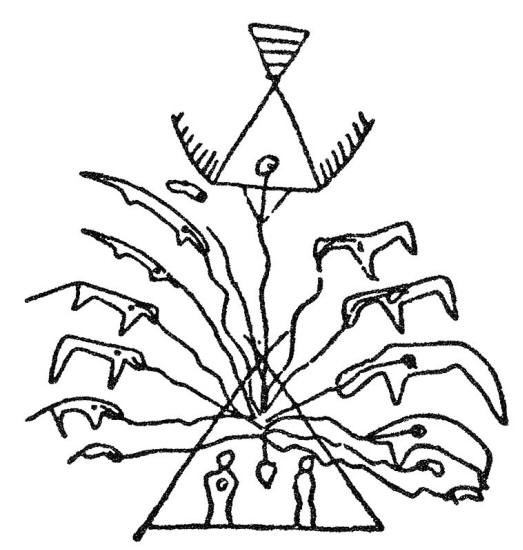
Fig. 5.
Ojibwa illustration showing the animal spirits
or manitous drawn upon by the Jessakkid
to conduct healings and ceremonies inside their lodges
called Jessakkan (from Hoffman 1891).
The Thunderbird, as the chief source of
magical power of the Jessakkid,
is seen directly above the lodge's smoke hole.
-
Was the Jessakkid
part of a long lineage that originated with the Denisovans
themselves?
-
Is this why these
wild shamans remained completely separate from the Ojibwa's
regular priesthood known as the Grand Medicine Society?
If correct, then it seems
possible that the ancestors of at least some Anishinaabeg were
descendents of an archaic hybrid population of pronounced Denisovan
ancestry, who descendants were remembered in legend as the
much-feared Thunder People-giant birds that could shape-shift into
human form by removing their "feather blankets."
In this form the Animiki' could mate with mortal humans and produce
offspring, some of whom might well have survived through to
historical times.
The Denisovan fossils
recovered so far from the Denisova Cave are particularly large in
comparison to those of modern human populations. (36)
This suggests that at
least some Denisovans were of enormous size and stature.
Giants of
Legend
So,
is it possible that
the Thunder People were not just Denisovan hybrids, but also
the giants of legend, whose
skeletal remains have been found in Native American mounds
across the United States? (37)
It was a hypothesis
proposed by the current author as far back as 2014. (38)
Yet as attractive as this
theory might seem, it is unlikely to be confirmed any time soon. All
skeletal remains of First Peoples held in national institutions and
museums within the USA were repatriated at the beginning of the
1990s as part of the
NAGPRA law.
So until oversized human
bones and teeth discovered in a true Native American context are
able to be DNA tested, little more can be said on the matter.
Despite this it does seem
increasingly likely that the lineal descendants of the Animiki' or
Thunder People of the Great Lakes region went on to become the elite
of early Native American mound-building cultures such as the Adena,
circa 1000-200 BCE, (39) as well as the ancestors of
indigenous shamanistic groups such as the Jessakkid of Ojibwa
tradition.
This last idea is backed
up by the high level of Denisovan DNA found even today among the
Ojibwa and Cree.
The figure
at top page,
exclusively reveals what the Animiki' or Thunder People might have
looked like. Note the figure's archaic facial features, large body
frame, feather coat, and oversized spear point.
The picture was
commissioned by the present author and executed by London artist
Russell M. Hossain.
Echoes of the
Past
If all this is correct then we should be able to find further
evidence of pronounced, over-sized Denisovan hybrids in many parts
of the North American landmass.
Most obviously they will
be remembered in Native American tradition as mythical beings of
great size and stature, who possessed supernatural powers including
the ability to control thunder, lightning, storms and rain.
Their memory will be
attached not only to familiar animistic forms such as thunderbirds,
eagles, falcons, vultures, ravens, and snakes, but also to the
highest and most primordial mountain shrines and retreats.
These might include sites
bearing "thunder" or "snake" place-names, as well as locations where
extreme weather patterns have long been recorded.
They former presence
might also be linked to find sites associated with exotic materials
traditionally thought to have originated in the sky world.
This will include the
dark, volcanic glass known as obsidian, which among the Yuki of
California, for example, is said to have been hurled to earth from a
single large block by a spirit named Milili. (40)
He apparently bore the
shape of a giant eagle or condor.
Such legends and stories will probably be found everywhere from the
American Northwest all the way down to California and Arizona in the
south. Where they do exist take note, for they could reveal key
information about the sacred places and power spots of the very
first peoples to inhabitant the American continent.
These, as we now suspect,
included the hybrid descendants of the Denisovan populations that
thrived in places like
the Altai Mountains of southern
Siberia down to around 40,000 years ago.
It is all these ideas and
more that are presented by Dr. Gregory Little, an expert on
the origins of America's mound-building cultures, and the current
author in a brand new book titled Denisovan Dawn - Hybrid Origins, Göbekli Tepe and the American Genesis, to be published in 2019
by Inner Traditions International.
Notes and
References
-
Qin and Stoneking
2015, figure 4. The paper cites that 0.17 percent of Ojibway
DNA is Denisovan implying that 0.17% is the overall mean
average for the tribe with many above and many below. From
this information it seems highly likely that within the
Ojibwa population there are many members who have very
little Denisovan ancestry, while others might have as much
as 3%.
-
Collins, 2018.
-
Qin and Stoneking
2015.
-
Qin and Stoneking
2015, 2669 fig. 4.
-
Qin and Stoneking
2015, 2669 fig. 4.
-
Hoffman 1891, 18.
-
Qin and Stoneking
2015, 2669 fig. 4.
-
Raghavan et al
2015.
-
Kratzer, Rall and
Forror 2008; Price 2012; Stephany 2007.
-
Hoffman 1891, 82.
-
Hoffman 1891, 9.
-
Jones 1916, 382.
-
Hoffman 1891, 73,
82.
-
Hoffman 1891, 9.
-
Hoffman 1891, 9.
-
Hoffman 1891,
157-158.
-
Houston-Jones
2009, 2. The Ojibwa name used is Pinesi Miikana, which
technically translates as the "path, trail, road, way (mikana)
of the great bird (binesi)." However, binesi (or pinesi) was
a word used also for the thunderbird, due to its large size.
See Baraga 1992 (1878), s.v. "Binesi," II, 86a; s.v. "Mikana,"
II, 237b. See also "Native American Legends: Binesi (Pinesi),"
http://www.native-languages.org/binesi.htm.
-
Kratzer, Rall and
Forror 2008; Price 2012; Stephany 2007.
-
Lankford 2007,
186, 208.
-
Jones 1916; Smith
1995, 77 (as recounted by Ojibwa elder William Trudeau in
1988).
-
Jones 1916.
-
Skinner 1923, 35.
-
Jones 1916, 384.
-
Jones 1916, 384:
"They fear the Thunder-birds."
-
Huerta-Sanchez,
2014.
-
Racimo et al
2017.
-
Hoffman (1891,
116) records a series of chants used in Mide'wiwin
initiations, each denoted by a simple mnemonic device. One
translates as, "The bird, the crow bird's skin is the reason
why I am a spirit," to which Hoffman comments: "Although the
crow is mentioned, the Thunder-bird (eagle) is delineated
[i.e. the chant's mnemonic device is the thunderbird]." Thus
the intimation is that the initiate's attainment of spirit
flight is attained through the animistic use of a crow's
"skin" (wai-yan) a reference surely to the use of
shamanistic paraphernalia. If so, this indicates an
inter-relationship in totemic terms between corvids and
thunderbirds.
-
Finlayson et al
2012.
-
Romandini et al
2014; Gannon 2015.
-
Grandin and
Johnson, 2005/2006.
-
Winkelman 2002.
-
Keys 2018.
-
Choi 2012.
-
"Thunderbird
(mythology)," World Heritage Encyclopedia.
-
Hoffman, 1891,
104.
-
For a full review
of this subject see, Collins 2014, available to read at
http://www.andrewcollins.com/page/articles/denisovan.htm,
and Collins 2018, chs. 40 and 41.
-
Two
greatly-feared Animikii are said to have inhabited Mount
McKay, otherwise known as Thunder Mountain (see Jones 1916,
384), or the Sleeping Giant of Thunder Bay. In Ojibwa
tradition this mafic sill, lying to the south of Lake
Ontario, is identified as Nana Bijou, a giant who revealed
the secret location of a silver mine to a chief named
Shinwauk. After the silver was used by the Ojibwa to create
jewelry, the existence of the mine came to the attention of
the Sioux, who were enemies of the Ojibwa. They sent a spy
into the Ojibwa camp to learn the whereabouts of the mine,
and when this was found out they sold this precious
information to the white men, who decided to exploit the
mine for themselves. However, Gitche Manitou, the Great
Spirit, saw what was happening and hid the entrance to the
mine, so that no one would ever find it again. For his role
in this great loss to the Ojibwa, the Great Spirit turned
Nana Bijou into stone, hence his role today as the Sleeping
Giant of Thunder Bay (for the full story see Veiileneuve
1981). It is tempting to connect Mount McKay's association
with the Animikii with the story of the giant Nana Bijou,
which, if correct, suggests that the Thunder People were
synonymous with the giants of North American legend.
-
See Collins 2014,
in Little 2014.
-
Little 2014.
-
Fox-Hudson 2007,
295.
Bibliography
Baraga, Frederic
[R.R. Bishop]. 1992 [1878/1880]. A Dictionary of the Ojibway
Language [Part I: English-Otchipwe, 1878; Part II: Otchipwe-English,
1880], St. Paul, Mn.: Minnesota Historical Society Press.
Choi, Charles Q. 2012."Genome of Mysterious Extinct Human
Reveals Brown-Eyed Girl." LiveScience, August 30.
www.livescience.com/22836-genome-extinct- humans-denisovans.html.
Collins, Andrew. 2014. "The Coming of the Giants: Rise of the
Human Hybrids," In Little, 227-239. - 2018.
The Cygnus Key: The Denisovan Legacy, Göbekli Tepe,
and the Birth of Egypt. Rochester, V.T.: Bear & Co.
Finlayson, Clive, et al. 2012. "Birds of a Feather: Neanderthal
Exploitation of Raptors and Corvids." PLOS One 7:10 (September
17, 2012), https://doi.org/10.1371/journal.pone.0045927.
Fox-Hudson, Susan. 2007. "Obsidian: Sacred Glass from the
California sky," in Piccardi and Masse, 295-313.
Gannon, Megan. 2015. "Neanderthals Wore Eagle Talons As Jewelry
130,000 Years Ago," LiveScience (March 11, 2015), https://www.livescience.com/50114-
neanderthals-wore-eagle-talon-jewelry.html.
Grandin, Temple, and Catherine Johnson. 2005/2006. Animals in
Translation: Using the Mysteries of Autism to Decode Animal
Behavior. San Diego, Calif.: Harcourt.
Hoffman, W. J. 1891. "The Mide'Wiwin or 'Grand Medicine Society'
of the Ojibwa." Seventh Annual Report of the Bureau of Ethnology
to the Secretary of the Smithsonian Institution, 1885-1886,
pages 143-300. Washington D. C.: Government Printing Office.
Houston-Jones, Jane. 2009. "First Nations Astronomy-seeing the
Cree and Ojibway Sky," Sonoma Skies: Newsletter of the Sonoma
County Astronomical Society (November 2009), 1-2.
Huerta-Sanchez, Emilia, et al. 2014. "Altitude adaptation in
Tibetans caused by introgression of Denisovan-like DNA," Nature
512:7513 (August 14, 2014), 194-
197.
Jones, William. 1916. "Ojibwa Tales from the North Shore of Lake
Superior, The Journal of American Folklore 29:113
(July-September 1916), 368-391.
Keys, David. 2018. "Prehistoric autism helped produce much of
the world's earliest great art, study says." Independent (May
14, 2018), https://www.independent.co.uk/news/science/archaeology/prehistoric-autism-
cave-paintings-barry-wright-penny-spikins-university-of-york-a8351751.html.
Kratzer, Gary D., Gloria D. Rall, and Doris Forror. 2008.
"Stories of the Early Americans," A Collection of Curricula for
the STARLAB Native American Mythology Cylinder. Buffalo, N.Y.:
Science First/STARLAB, D7-D20.
Lambrecht, Kalman. 1933. Handbuch der palaeornithologie. Berlin:
Gebrüder Borntraeger.
Lankford, George E. 2007. "The 'Path of Souls': Some Death
Imagery in the Southeastern Ceremonial Complex". In Reilly III
and Garber, 174-212.
Little, Dr Greg, forward and afterward by Andrew Collins. 2014.
Path of Souls: The Native American Death Journey. Memphis,
Tenn.: Eagle Wing Books.
Piccardi, L., and W. B. Masse. 2007. Myth and Geology (Special
Publications No. 273). London: Geological Society.
11
Price, Michael Wassegijig. 2012. "Stellar Connections:
Explorations in Cultural Astronomy-Pt. 2." Transcription of
lecture, https://wiki2.org/en/White_Earth_Tribal_and_Community_College.
Lecture on video, https://www.youtube.com/watch?v=nVny6LnTOLg.
Qin, Pengfei, and Mark Stoneking. 2015. "Denisovan Ancestry in
East Eurasian and Native American Populations," Molecular
Biology and Evolution 32:10, 2665- 2674.
Racimo, Fernando, et al. 2017. "Archaic Adaptive Introgression
in TBX15/WARS2," Molecular Biology and Evolution 34:3 (March 1,
2017), 509-524.
Raghavan, Maanasa, et al. 2015. "Genomic evidence for the
Pleistocene and recent population history of Native Americans,"
Science 349:6250, aab 3884:1-10.
Reilly, F. Kent, and James F. Garber, eds. 2007. Ancient Objects
and Sacred Realms: Interpretations of Mississippian Iconography.
Austin: University of Texas Press. Romandini, Matteo, et al.
2014. "Convergent Evidence of Eagle Talons Used by Late
Neanderthals in Europe: A Further Assessment on Symbolism," PLoS
ONE 9:7, e101278 (July 10, 2014) https://doi.org/10.1371/journal.pone.0101278.
Sankararaman, Sriram, Swapan Mallick, Nick Patterson, and David
Reich. 2016. "The Combined Landscape of Denisovan and
Neanderthal Ancestry in Present-Day Humans," Current Biology
26:9 (May 9, 2016), 1241-1247.
Skinner, Alanson. 1923. Observations on the Ethnology of the
Sauk Indians, Volume 5. Wilwaukee, Wis.: Order of the Board of
Trustees.
Smith, T. S. 1995. The Island of the Anishnaabeg. Moscow, Id.:
University of Idaho Press.
Stephany, Timothy J. 2007. "The Great Thunderbird: Source of the
American Indian Symbol," http://timothystephany.com/papers/Article-Thunderbird_rev09b.pdf.
Veiileneuve, Jocelyne. 1981. Nanna Bijou, The Sleeping Giant (An
Ojibway Legend). Newcastle, Ontario, Canada: Penumbra Press.
Winkelman, Michael. 2010. Shamanism: A Biopsychosocial Paradigm
of Consciousness and Healing. Santa Barbara, Calif.: ABC-CLIO.
Acknowledgments
Thanks to Debbie Cartwright, Doug Kenyon, Russell M. Hossain, Greg
Little, Richard Ward, Tim Yearington, and Augustus Frates, for their
help during the research and writing of this article.
|







